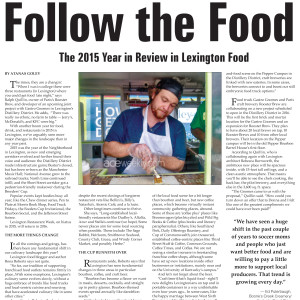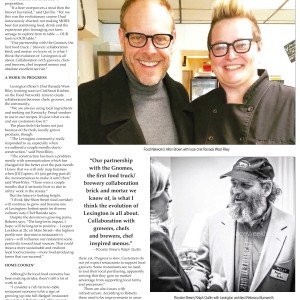2015 Year in Review: Changes in Lexington Food Culture Bring the Community Closer Together
BY ATANAS GOLEV
“When I was in college there were three restaurants (in Lexington) where you could get food late night,” says Ralph Quillin, owner of Paris’s Rooster Brew, and developer of an upcoming joint project with Gastro Gnomes in Lexington’s Distillery District. He adds, “There was really no ethnic, no farm to table — Jerry’s, McDonald’s, and KFC were big.”
The times, they are a-changin’.
2015 was the year of the Neighborhood in Lexington, as new and emerging corridors evolved and further found their voice and audience: the Distillery District made infrastructure gains; Buster’s closed, but has been re-born as the Manchester Music Hall; National Avenue grew to the railroad tracks; North Lime continued infill; and the Short Street corridor got a pedestrian-friendly makeover during the Breeders’ Cup.
Popular events kept foodies busy all year, like the Chew dinner series, Pen to Plate at Morris Book Shop, Food Truck Fridays, the Feeders Cup Invitational, the Bourbon Social, and the Jefferson Street Soiree.
Lexington Restaurant Week, on hiatus in 2015, will return in 2016.
The More Things Change



In all the comings and goings, has there been any fundamental shift in our culinary landscape this year?
Lexington food blogger and author Rona Roberts says not quite.
“So far, our tradition of supporting franchised food outlets remains firmly in place…With some exceptions, Lexington’s culinary scene evolves slowly, without a huge embrace of trends like food trucks and local-centric cuisine and sourcing that have accelerated culinary life in some other cities.”
According to Roberts, the least dramatic change has been in restaurants, despite the recent closings of longterm restaurant vets like Bellini’s, Billy’s, Natasha’s, Atomic Café, and a la lucie.
Other longtimers continue to thrive.
She says, “Long-established local-friendly restaurants like Dudley’s, Alfalfa, Azur and Stella’s continue… Some newer places aim for some local sourcing when possible. These include The Sage Rabbit, Heirloom, Smithtown Seafood, County Club, Graze, and Windy Corner Market, and possibly Herbe.”
The Cup Runneth Over
Roberts does say that Lexington has seen fundamental changes in three areas in particular: bourbon, coffee, and craft beer.
“Bourbon has become a flavor we want in meals, desserts, cocktails, and straight up in pretty glasses. Bourbon-themed events spread annually like dandelion seeds.”
Coffee has led to another local boom.
“Locally roasted coffee has been part of the local food scene for a bit longer than bourbon and beer, but new coffee places, which become virtually instant community gathering places, abound. Some of these are ‘coffee plus’ places like Broomwagon (plus bicycles) and Wild Fig Books & Coffee (plus books and literary paraphernalia). Others, like Southland Perk, Daily Offerings Roastery, and Cup of Commonwealth, join treasured, established coffee-centric places like Third Street Stuff & Coffee, Common Grounds, Coffee Times, and Coffea. We are not seeing a similar increase in freestanding franchise coffee shops, although some have set up new locations inside other businesses or institutions, mainly near and on the University of Kentucky’s campus.”
And let’s not forget about the beer.
“Craft beer (that’s liquid food – right?) now delights Lexingtonians on tap and in portable containers in a way unthinkable even four years ago… In some cases, like the happy marriage between West Sixth Brewing and Smithtown Seafood as well as the somewhat more dispersed alcohol-and-food scene on the Pepper Campus in the Distillery District, craft breweries are linked with new eateries. In some cases, the breweries connect to and boost our still embryonic food truck options.”
More fruits of this cooperation are coming soon.
Food truck Gastro Gnomes and Paris craft brewery Rooster Brew are collaborating on a new project scheduled to open in the Distillery District in 2016. This will be the first brick and mortar location for the Gastro Gnomes and an expansion for Rooster Brew. They plan to have about 20 local brews on tap, 10 Rooster Brews and 10 from other local brewers. Their location on the Pepper campus will be in the old Pepper Bourbon Barrel House’s first floor.



According to Quillin, who is collaborating again with Lexington architect Rebecca Burnworth, the ambitious new place will be spacious inside, with 15-foot tall ceilings, and a clean ascetic atmosphere. That means you’ll be able to see the chefs cooking, the back bar, the pilot brewery, and everything else in the 3,600 sq. ft. space.
“The Gnomes came to us with the proposal,” Quillin said. “How could you turn down an offer that to Donna and I felt like one of the greatest compliments we could have ever been paid?”
He welcomes the collaborative proposition.
“If a beer overpowers a meal then the brewer has failed,” said Quillin. “For me this was the evolutionary course I had innocuously charted, not making MORE beer but combining food, drink and the experience plus leveraging our farm acreage to explore farm to table — OUR farm to OUR table.”
“Our partnership with the Gnomes, the first food truck / brewery collaboration brick and mortar we know of, is what I think the evolution of Lexington is all about. Collaboration with growers, chefs and brewers, chef inspired menus and absolute excellent service.”
21c: A Work in Progress
More and more cooperation can be seen throughout the community, and its effects can be pivotal.
Lexington Diner’s Chef Ranada West-Riley (coming soon to Cutthroat Kitchen on the Food Network) has aimed to create collaboration between chefs, growers, and the community.



“We are always using local ingredients and seeking out Kentucky Proud vendors to use in our recipes. It’s just what we do and our customers love it.”
The place feels like home not just because of the fresh, locally grown products, though.
“The Lexington community really responded to us, especially when we suffered a couple months due to construction,” said West-Riley.
“The construction has been a problem mostly with communication which has changed for the better over the past month. I know that we will only reap business when [21C] opens, it’s just getting past all the inconveniences to make it until then,” said West-Riley. “There were a couple months that it seriously hurt us due to utility work in the streets.”
But the future is looking bright.
“I think (the Short Street food corridor) will continue to grow and become one of Lexingtons hottest spots for diverse culinary eats,” Chef Ranada says.
Despite the downtown growing pains, Roberts says, “The long-term impact, I hope, will be positive… I expect Lockbox at 21c on Main Street—the highest profile new downtown restaurant in years—will influence our restaurant scene positively toward local sources. That could mean a more sustainable and resilient local food economy—more food-producing farms that can succeed.”
Home Cookin’



Although the local food economy has been making strides, there’s still a lot of work to do.
“I consider a rich farm-to-table restaurant economy to be a sign of growing up into full-fledged ‘restaurant city’ status,” Roberts says. “We are not there yet. Progress is slow. Customers do not yet expect restaurants to support local growers. Some restaurants see no need to tout their local purchasing, apparently sensing that they gain no market advantage from supporting local farms and processors.”
There are also issues with infrastructure. According to Roberts there need to be improvements in areas as diverse as transportation, processing, aggregation, and distribution of individual farms’ products.
The University of Kentucky’s recent move to privatize dining services has also been a step back for the community’s relationship with local food.
“University of Kentucky’s decision (provided) corporate food to students instead of seizing an opportunity to cultivate students’ life-long commitment to Kentucky-grown food and cuisine,” says Roberts. “UK Dining/ Aramark’s corporate/franchise orientation fails to build in future Kentucky adults the habit of long-term enthusiasm for locally grown ingredients, offered in locally owned Kentucky restaurants. In addition, while this may change over time, UK administration’s pro-corporate decision has yet to support the genuine local food economy at large scale.”
There are many bright spots, though.
Restaurants like Ouita Michel’s empire (Holly Hill Inn etc) , “deserve accolades” for their commitment to locally grown food, says Roberts.
“Locally-raised farm to table ingredients have skyrocketed in Lexington,” adds Lexington Diner’s West-Riley. “It’s becoming more mainstream, almost expected, and I just love that. It builds relationships within the community and keeps the money local. It’s a win -win and it seems even large corporations are on board as well.”
The increased interest in local products has also been acknowledged by Ed Puterbaugh, owner of Boone Creek Creamery. Puterbaugh opened a Kentucky Proud Store on Palumbo Drive at the end of November because of the shift in how much Lexingtonians care about local.
Boone Creek Creamery is an artisan cheese producer in Lexington. Puterbaugh explains, “Visitors tour the cheese making operation, watch a nice informational video and sample some of our cheeses. Then they are welcome to purchase cheese and browse the Kentucky Proud Store.”
He says, “When we started selling cheese at the Farmer’s Markets a few years ago, our customers were all ‘foodies,’’’ says Puterbaugh. “We have seen a huge shift in the past couple of years to soccer moms and people who just want better food and are willing to pay a little more to support local producers. That trend is growing every day.”
Kentucky native and food author Ronni Lundy (now living in North Carolina) published Sorghum’s Savor in 2015. She told us during the book tour, “The people I’ve met in Kentucky in the last couple of year working in food economies, small farming and producing, are incredibly smart and aware of what’s going on. They just need support from the state and from their neighbors.”
Crank & Boom / Thai and Mighty owner Toa Green agrees.
“I think Lexington’s culinary scene has really evolved in the variety in styles and cultures that have emerged in the last few years. I also think diners are becoming more educated and sophisticated in their palate and are demanding delicious food that’s interesting and well made.”
Green is also grateful for the community’s support. New fans “are surprised to find out that we started in the back of a Thai restaurant and that having an ice cream company was never a part of any plan. That the idea just happened by accident and has grown organically —I think that is a major part of our success.”



The new Crank & Boom location is another recent addition to the burgeoning Distillery District. And Green thinks that there will be more to come.
“As more businesses open in the next year, I think the Pepper Campus is going to become even more of a destination for locals and for visitors. The Pepper Campus is unique in that not only are all the business owners local to Lexington, the building owners are also all local. So we all have a strong incentive to make the campus as fun and inviting as possible.”
With the evolution of the food scene in Lexington, especially within the last year, the consensus seems to be that a focus on food is bringing the community closer together.
The times, they are a-changin’. But the community spirit remains the same.
“A great community is defined by its art/culture (food is included here) and how it treats it citizens,” says Quillin. “Start there and there is no downside.”
For an additional listing of restaurants which opened and closed in Lexington in 2015: Births, Resurrections, Obits, and Transitions, click here.
This article also appears on pages 4-5 of the December 2015 printed issue of Ace.
Subscribe to the Ace e-dition for Lexington news, arts, culture, and entertainment, delivered to your inbox every Thursday morning.








